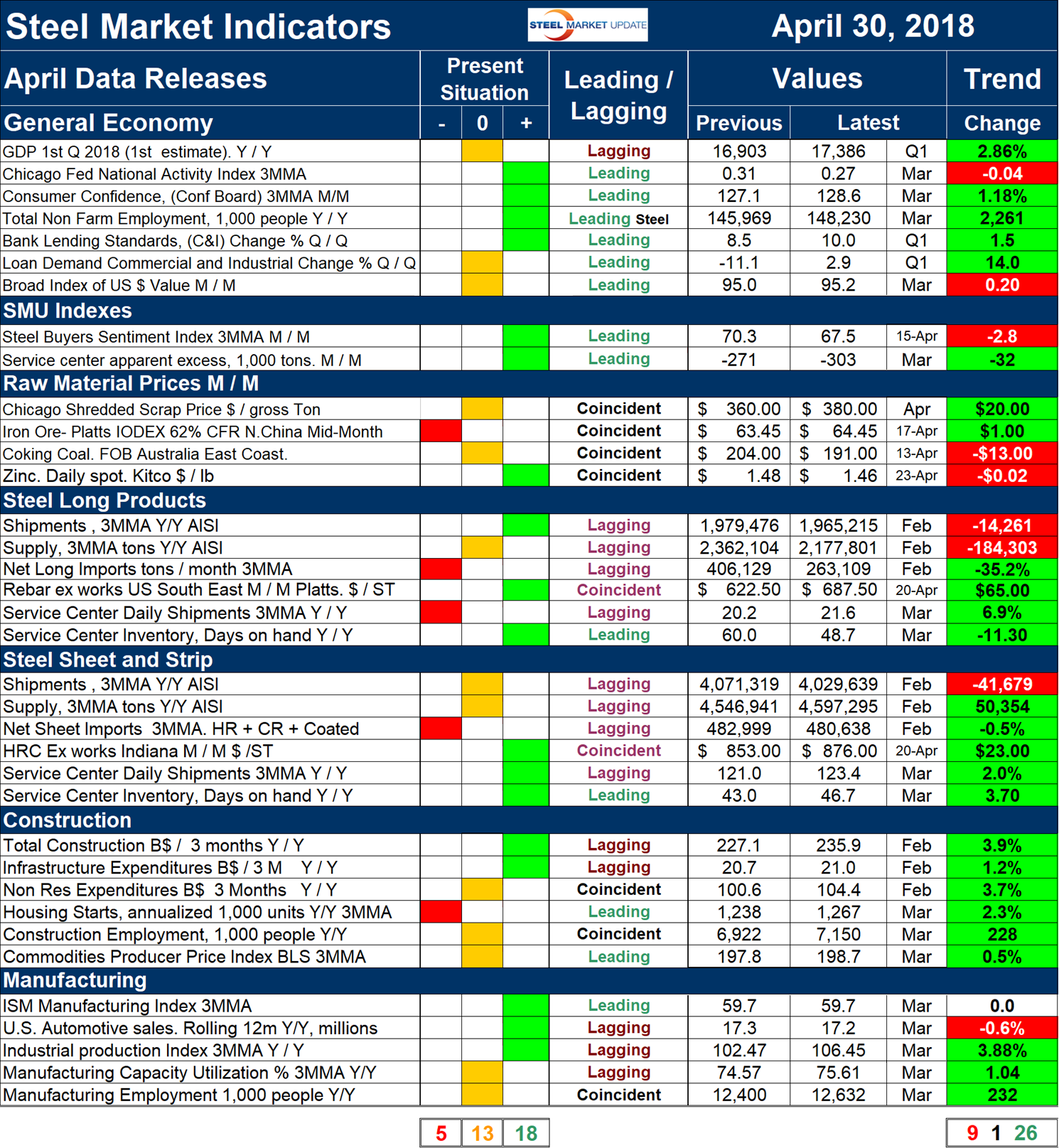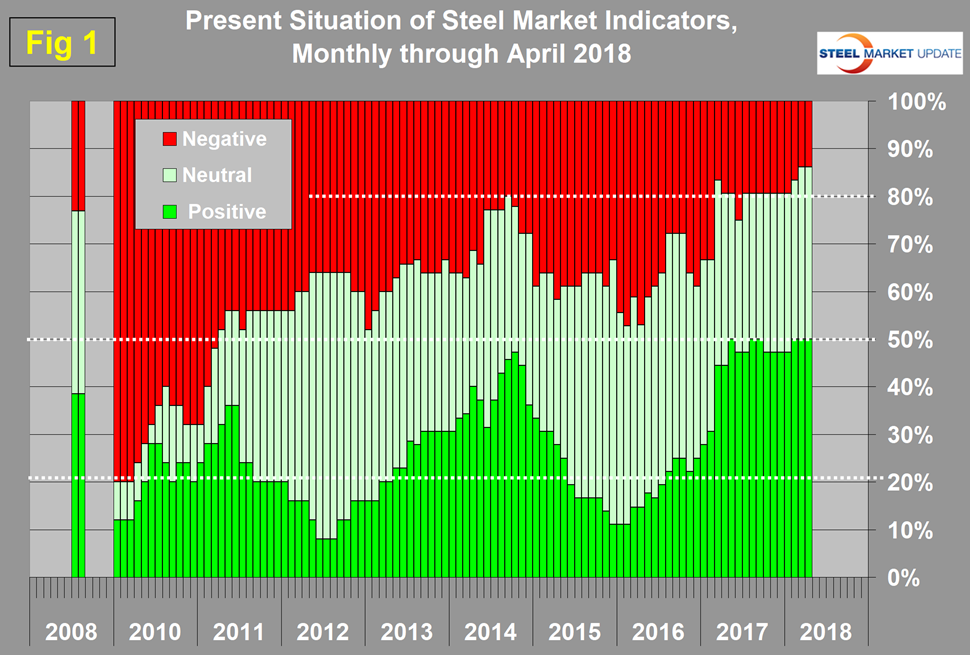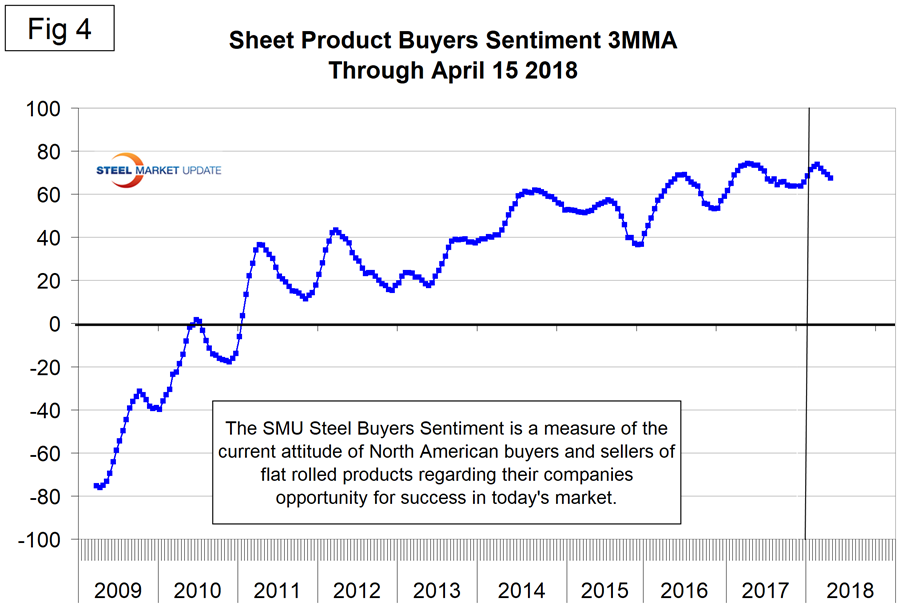SMU Data and Models

SMU Analysis: Key Market Indicators Weakening?
Written by Peter Wright
April 30, 2018
Key market indicators tracked by Steel Market Update are at an all-time high for April but have shown signs of weakening in the past few months.
Data released in April shows that 18 of the 36 indicators are historically positive with only 5 negative. The balance is within the historically normal band. Trends took a step back falling from 32 positive in February to 28 positive in March and 26 positive in April. Trends lead the present situation by about four months.
See the end of this piece for an explanation of the Key Indicators concept. This will explain the difference between our view of the present situation, which is subjective, and our analysis of trends, which is based on the latest facts available.
Please refer to Table 1 for our view of the present situation and the quantitative measure of trends. Readers should regard the color codes in the present situation column as a visual summary of the current market condition. The “Trend” columns of Table 1 are also color coded to give a quick visual appreciation of the direction the market is headed. All data included in this table was released in April. The month or specific date to which the data refers is shown in the second column from the far right. All results are the latest available as of April 30, 2018.

Present Situation
In April, there was no net change in the number of positive, neutral and negative indicators but there were changes in the detail. We currently view 18 of the 36 indicators as positive, 13 as neutral and 5 as negative. Our intent in using the word neutral is to say that this indicator is in the mid-range of historical data. Figure 1 shows our monthly assessment of the present situation since January 2010 on a percentage basis. The number of negative perceptions is the lowest it has ever been in the history of this analysis.
The following changes were made in April: Service center apparent excess was re-classified from neutral to positive when its value declined to negative 303,000 tons. This is a proprietary SMU index that measures the level of service center receipts in relation to shipments. A deficit by its magnitude is an indication of future pricing power as inventories are lean. Or vice versa. In the raw materials section, the price of coking coal FOB Australia’s East Coast declined to less than $200 and we re-classified from positive to neutral. There were no changes in the long products section. In the sheet section, service center daily shipments were re-classified from neutral to positive. In the construction section, expenditures on nonresidential buildings were re-classified from positive to neutral. There were no changes in our perception of the manufacturing indicators.

Trends
Most values in the trends columns are three-month moving averages (3MMA) to smooth out what can be very erratic monthly data. Trend changes in the individual sectors since the end of March data are described below together with some general comments. (Please note in most cases this is not April data but data that was released in April for previous months.)
Figure 2 shows the trend of the trends and the pre-recession situation at the far left of the chart. The proportion of trends that are improving is now 72.2 percent of the 36 indicators. This was a decline from an all-time high of 88.9 percent in February.

Our observations about trends in the April data are as follows: The first release of the growth of GDP in the first quarter of 2018 was released on Friday. On a rolling 12-month basis, the growth of GDP has improved for seven straight quarters and is now 2.86 percent. In the General Economy section of Table 1, there was one trend reversal when the Chicago Fed National Activity Index declined, albeit from a strong position. There were no trend reversals in the SMU proprietary indexes section. Service center excess of sheet products continued to improve in the March data. We regard an inventory deficit to be positive in terms of pricing power. In March, the surplus declined from positive 271,000 tons to negative 303,000 tons (Figure 3). The steel buyers’ sentiment continued to weaken and declined from 70.3 in February to 67.5 in March (Figure 4).


In the raw materials section, there was one trend reversal when the price of iron ore increased by $1.00. This was a respite from our March report when three of the four declined. We regard falling raw materials prices as negative and indicative of a weakening global market.
In both the long products and sheet sections, there was one reversal when mill shipments declined in the latest data, which was for February.
In the construction sector, all indicators are trending positive. There was one reversal when housing construction expenditures in March reversed direction and trended positive. In our manufacturing indicators, the only change was that in March the ISM index was unchanged, having had positive growth in February.
We believe a continued examination of both the present situation and direction is a valuable tool for corporate business planning.
Explanation: The point of this analysis is to give both a quick visual appreciation of the market situation and a detailed description for those who want to dig deeper. It describes where we are now and the direction the market is headed and is designed to describe the situation on a specific date. The chart is stacked vertically to separate the primary indicators of the general economy, of proprietary Steel Market Update indices, of raw material prices, of both sheet and long product market indicators, and of construction and manufacturing indicators. The indicators are classified as leading, coincident or lagging as shown in the third column.
Columns in the chart are designed to differentiate between where the market is today and the direction it is pointing. Our evaluation of the present situation is subjectively based on our opinion of the historical value of each indicator. There is nothing subjective about the trends section, which provides the latest facts available on the date of publication. It is quite possible for the present situation to be predominantly red and trends to be predominantly green or vice versa depending on the overall situation and direction of the market. The present situation is subdivided into, below the historical norm (-), (OK), and above the historical norm (+). The “Values” section of the chart is a quantitative definition of the market’s direction. In most cases, values are three-month moving averages to eliminate noise. In cases where seasonality is an issue, the evaluation of market direction is made on a year-over-year comparison to eliminate this effect. Where seasonality is not an issue, concurrent periods are compared. The date of the latest data is identified in the third values column. Values will always be current as of the date of publication. Finally, the far-right column quantifies the trend as a percentage or numerical change with color code classification to indicate positive or negative direction.

Peter Wright
Read more from Peter WrightLatest in SMU Data and Models

SMU Survey: Sheet lead times ease further, plate hits one-year high
Steel buyers responding to this week’s SMU market survey report a continued softening in sheet lead times. Meanwhile, plate lead times have moderately extended and are at a one-year high.

SMU Survey: Buyers report more price flexibility from mills
Nearly half of the steel buyers responding to this week’s SMU market survey say domestic mills are showing increased willingness to negotiate pricing on new spot orders. This marks a significant shift from the firmer stance mills held in prior weeks.

SMU Survey: Buyers’ Sentiment Indices fall
Current Sentiment Index dropped six points to +42 this week compared to two weeks earlier. It has fallen in every successive survey since reaching a 2025 high of +66 on Feb. 19.

March service center shipments and inventories report
Steel service center shipments and inventories report through March 2024.

Apparent steel supply contracts in February
The amount of finished steel that entered the US market in February receded from January’s peak, according to our analysis of Department of Commerce and American Iron and Steel Institute (AISI) data.
